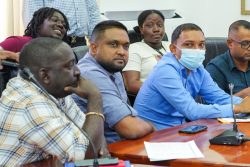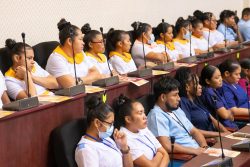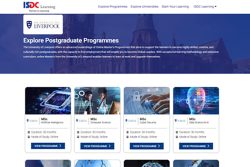This week, on Thursday, September 18, four schools, all tertiary colleges specialising in the creative arts disciplines in Guyana, will hold their 2014 Convocation ceremony at the National Cultural Centre. These are the National School of Theatre Arts and Drama, which is new; the National School of Music; and the two oldest and most established institutions – the National School of Dance and the Burrowes School of Art. The Schools of Music and Dance, although they have been training performers, will have a convocation for the first time, while the two-year old School of Drama has its second such ceremony after its inaugural exercise last year. What is new for them all, is that it will be the first joint convocation under the new umbrella of the Institute of Creative Arts being set up by the Ministry of Culture.
This joint Convocation signals the arrival of the Institute that will be coordinating the four schools which have been running as independent units. The newest of them is the School of Theatre Arts and Drama which graduated its first set of students in 2013 and is now about to certify its second on Thursday. Last year 12 drama students successfully completed the programme with a Diploma in Theatre Arts and Drama. There is a slightly increased number graduating this year in both the Certificate in Theatre Arts and the Diploma.
The School of Music was established by the Ministry of Culture and has been offering tuition in music and proficiency in performing instruments for a number of years to persons of all ages and levels of proficiency. However, they have been preparing students for the various Grades offered by the external examining bodies. This is the first time the public music school will actually graduate students and craft diploma programmes of its own.
 The National School of Dance was established in 1973 by the government and for decades was the only full institution offering formal training in any area of the performing arts. Dance has developed and expanded considerably in Guyana to a very large extent because of the technical training available. Although several private dance schools and companies operate in the country today, the majority of them owe their very existence to the off-shoots and spin-offs from the National School of Dance. There was rigid formal training; there were one-off courses for dance teachers, but no ongoing routine formal certification in dance. This is the first time that the school will offer this at a convocation.
The National School of Dance was established in 1973 by the government and for decades was the only full institution offering formal training in any area of the performing arts. Dance has developed and expanded considerably in Guyana to a very large extent because of the technical training available. Although several private dance schools and companies operate in the country today, the majority of them owe their very existence to the off-shoots and spin-offs from the National School of Dance. There was rigid formal training; there were one-off courses for dance teachers, but no ongoing routine formal certification in dance. This is the first time that the school will offer this at a convocation.
The Burrowes School of Art was founded by artist, archaeologist and anthropologist Denis Williams in 1975 and has continuously offered Certificate and Diploma programmes in the visual arts – mainly painting, sculpture, drawing, ceramics, graphics, textiles, and leathercraft. Areas of the fine arts – especially painting and sculpture, have been strong and Guyana has produced outstanding artists, many of them graduates of the art school. The annual exhibition of the work of students has long been a feature, and this year that show has been mounted in the upper and lower foyers of the National Cultural Centre. That is an impressive accompaniment to the graduation ceremony they will have on Thursday evening in conjunction with the other three schools under the new Institute of the Creative Arts.
These two old schools have been contributing to the strength of the visual arts and dance in Guyana for decades. For a long time these were the only disciplines in the arts in which formal technical training was available on a large scale to the population. Some years after the establishment of the art school the University of Guyana started its Fine Arts programme eventually offering the degree. Drama was also studied there, but limited to students majoring in English. It is difficult for dance to be performed at a national level by rank amateurs without technical exposure, because of the skills and techniques necessary. The presence of the national dance school was therefore fortunate because it has helped to sustain dance at high levels of proficiency since people were being trained. The work of these two schools therefore returned dividends at the national level.
Further development in dance has been evident in the fact that a National Dance Company was also created in 1979. This professional extension of the school has always been a continuing part of its output, kept afloat by its best graduates who become members of the company. There has been a very high rate of migration among the trained dancers but the continuous existence of the training offered by the school has lent some depth to the human resources, ensuring that the company continues. But members of the company have also gone on to start other private companies, dance groups and schools offering training privately. Now the introduction of official certification can only multiply the depth and contribution of this production of trained dancers fed into the national system.
The way the Burrowes School of Art has been making a similar contribution to national art may be seen in the increasing number of professional artists who have made an impact after graduating from Burrowes. There has also been a corresponding drain of professionals through emigration, but Burrowes has been turning out graduates for more than 30 years and the way they add to art at the national level is more than hinted at in the school’s exhibitions. Some weeks ago there was an exhibition of the work of the tutors, while at present there is the annual students’ exhibition now given much more public exposure by being mounted at the Cultural Centre. It is impressive, giving a good idea, not only of the quantity, since there are innumerable pieces on show, but also of the very wide range of work being done. In evidence are studies in painting, sculpture, pottery, graphic design and expressive graphic pieces, drawings, fabric prints and textiles. Some of the students have already begun to assume expressive identities and show promise of a career after school.
There has always been tutoring taking place for students of music, and several musicians have emerged with qualifications gained in the external examinations. But until recently, this was entirely privately done by music teachers, and music in the secondary schools has always been below the demand. The formation of the National School of Music meant that the public system was now strengthened and persons could go there since additional opportunities were offered. But it was an extension of the same types and levels of training being provided by the private tutors. The new Institute of Creative Arts now means that the offerings of the music school will be broadened and will become more meaningful, since this school will now begin to offer certificates and diplomas. Students can now study academic programmes in music to take them well beyond proficiency in the playing of an instrument.
The newest of these schools is the School of Drama which has already demonstrated the possibilities less than two years after opening its doors. The 2013 Diploma students produced work which they performed at Carifesta XI in Suriname. They were also graded partly on the basis of public performance of their work as a condition of graduation in the summer of 2013. Those who graduated from that have already gone on to show the difference and the impact of their training first of all in the 2013 National Drama Festival in which they entered plays of their own and were a part of the cast and crew of other productions. It was further shown by the several prizes that they won in the contest.
Another class is about to graduate on Thursday in both the Diploma and Certificate. Their public performances have already included The Performance, a full production of theatre at the Cultural Centre in April, 2014. This included various performance pieces developed in class, through research and from improvisation such as The Sirens, an excerpt from Greek drama – Lysistrata and a version of Ol Higue that has been in such high demand it has been performed several times in different places. The Performance II showed their graduation test pieces – a full length drama Pandora’s Box, a shorter piece The Trouble With Neketa and a demonstration of researched Caribbean performance, The Stick Fight.
However, apart from the high acclaim received by those productions, these graduates and students have already made an impact in their contribution to the teaching of drama in secondary schools. Many schools have become new entrants in CXC drama led by the work of teachers who are either graduates of the drama school or current students.
The creation of Guyana’s Institute of Creative Arts will solidify the four existing schools and bring their work together, allowing the students of one school to benefit from courses offered in another and widen their training and experience. Very important, as well, is Guyana’s entry into the trend of creative arts education that has already taken off elsewhere in the Caribbean. The Edna Manley College in Jamaica has united the oldest such schools in the Caribbean – the Jamaica School of Art, the Jamaica School of Music, the School of Dance first created by the NDTC, and the School of Drama which once trained all the dramatists from around the Caribbean. These also joined forces with the Creative Arts Centre at UWI, Mona.
This example has been followed by Trinidad and Tobago where similar work developed at the Department of Creative and Festival Arts at UWI St Augustine, and the training now offered at the University of Trinidad and Tobago. In Barbados, such training exists at the Barbados Community College but it has now been multiplied by the opening of the Errol Barrow Centre at the UWI Cave Hill Campus. Guyana’s Institute will be the newest in this line of development.








